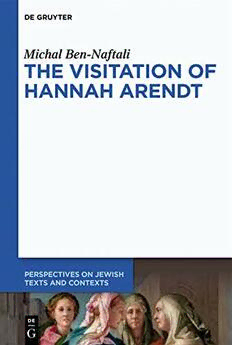
The Visitation of Hannah Arendt PDF
Preview The Visitation of Hannah Arendt
Michal Ben-Naftali The Visitation of Hannah Arendt Perspectives on Jewish Texts and Contexts Edited by Vivian Liska Editorial Board Robert Alter, Steven E. Aschheim, Richard I. Cohen, Mark H. Gelber, Moshe Halbertal, Christine Hayes, Moshe Idel, Samuel Moyn, Ada Rapoport-Albert, Alvin Rosenfeld, David Ruderman, Bernd Witte Volume 13 Michal Ben-Naftali The Visitation of Hannah Arendt Published in Hebrew by the Van Leer Jerusalem Institute and Hakibbutz Hameuchad Publishing House, 2006. Translated from Hebrew by Mirjam Hadar. ISBN 978-3-11-066309-9 e-ISBN (PDF) 978-3-11-066347-1 e-ISBN (EPUB) 978-3-11-066430-0 ISSN 2199-6962 Library of Congress Control Number: 2020933296 Bibliographic information published by the Deutsche Nationalbibliothek The Deutsche Nationalbibliothek lists this publication in the Deutsche Nationalbibliografie; detailed bibliographic data are available on the Internet at http://dnb.dnb.de. © 2020 Walter de Gruyter GmbH, Berlin/Boston Printing and binding: CPI books GmbH, Leck Cover image and frontispiece: Pontormo (Carucci, Jacopo called 1494-1556): Visitation (post 2014 restoration). Carmignano, San Michele. © 2020. Photo Scala, Florence www.degruyter.com Contents Chapter 1 Visitation 1 Chapter 2 Rahel’s Dream 12 Chapter 3 The Visitation of Dahlia Ravikovitch 44 Chapter 4 An Anonymous Hand in the Middle 57 Chapter 5 Mother Tongue|Body Language: 72 Chapter 6 Stefan Zweig 107 Chapter 7 The Visitation of Michal, Daughter of Saul 146 Bibliography 173 Chapter 1 Visitation 1. On receiving the Annunciation from the archangel Gabriel, the Virgin Mary learns that her aging relative Elizabeth, too, infertile until then, is six months pregnant. Mary decides to pay her a visit.The reason for this visit is not men- tioned. All this happens,writes Jean-Luc Nancy (2001a), as though the miracle had to be confirmed twice over,by means of two mysterious and inconceivable pregnancies. Mary’s “visitation” with Elizabeth comes close on the heels of the archangel’s, and before that, God’s visitation; resonating them. It also inaugu- rates a broad semantic field, reminding us of the Biblical Hebrew root P.K.D. [דקפ]–visit,befall–whichmovesbetweentheextremesoffavorableanddisa- greeableremembering;betweenrecompenseandpunishment;betweenpresence and absence. “Visitation” connotes scrutiny, experiencing something, and ren- dering yourself account of the experience or the trial. God visits Elizabeth and Mary.Way back in the past he had visited Sarah, wife of Abraham.The book of Genesis sets down two principles of origin: the principleofspiritandtheprincipleofflesh,theprincipleofSarahandtheprin- cipleofHagar.Thetensionbetweenthesetwoprinciplescausedtheveryideaof thefamilytotearapart.¹ThegospelofLuke,however,whichdocumentsthevis- itation, erases any such antagonism. Not only is God present in the womb of both women, but they both believe that each of them, both herself as well as the other, has the power to give life. “And it happened,when Elizabeth heard thegreetingofMarythatthebabeleapedinherwomb;andElizabethwasfilled with the Holy Spirit. Then she spoke out with a loud voice and said, ‘Blessed are you among women, and blessed is the fruit of your womb! But why is this granted to me, that the mother of my Lord should come to me? For indeed, as soon as the voice of your greeting sounded in my ears,the babe leaped in my womb for joy’ “ (Luke:41–44). Where and whence does all this come to pass? What is the source of preg- nancy,oflight?Howdoweapproach asublime region,beyond memory,before birth? Where is the topos or atopos where natality is born, a spiritual, mental Galatians4:22,NJKV:“ForitiswrittenthatAbrahamhadtwosons,onebyaslavewomanand onebyafreewoman.Butthesonoftheslavewasbornaccordingtotheflesh,whilethesonof thefreewomanwasbornthroughpromise.” https://doi.org/10.1515/9783110663471-001 2 Chapter1Visitation place-without-place, a complexcombination of voices and devotion,vision and awe? Near Elizabeth’s house,out in the open, and perhaps near us,amongus? In his depiction ofthis scene,the Italianpainter Pontormo’s knowinghand and listening heart (“The Visitation”, 1528–1530) submerge us all at once, far away from theological and dogmatic constraints, into the very bowels of the painting,thekeysofcreation.Thewomen’sarmsembracing,thedelicatelyintent clasping of hands, their bellies hardly touching, the torrent of textiles, colors flowingtogetherandapart,thefeetliftingfromthegroundasindance,suspend- edandstatic;thegoldenendsofMary’slocksdefiantlypeepingoutfromunder hercoif.Andmorethananything,thegaze,submersioninthegaze,eyetoeye, drawing in all the senses.Conception occurs in the gaze. Butthisdepictionofthevisitationincludestwoadditionalfigures–theserv- ants.Theyarecopies,itwouldseem,oftheirmistresses–theyaretheirage,wear theirhairsimilarly,andaredressedinthesamecolors.Butthisiswheresimilar- itiesend.Thecopyafterallistheuncannydoubleoftheorigin,theuncannypo- tentialofthevisitation.Theservantsarenotpregnant.Elizabeth’sservantispart of the triangle,while Mary’s pulls its axis to the left of the painting.They look neither at each other nor at their mistresses. Both look us directly in the face. Their gaze challenges us and might be trying to lock with ours. Though the younger servant’s gaze is perhaps more inviting and illuminated than the more serious look of the other, older one, neither reveals her feelings.What do their expressions seek to convey? A respect for the intense intimacy they wit- ness?Embarrassment,resignation,fatalism,yearning,terror?Aretheyexcluded fromthevisitation,inthefullestsenseoftheword?Onthecontrary:foritisonly through them, as we return their gaze, that we enter the picture. No one, it seems, is barred from this visitation. This embrace brings together the whole church,theentireflock,thefullcommunity,thoughitassignsmembersverydif- ferent roles – roles they themselves don’t yet know. 2. Sometimes,inthecourseofreading,awriterbecomesacompanion,asifmaking a protracted visit, then vanishing as suddenly as he appeared. This real and phantom author-hero seems sensitive to his reader’s vital motions; he besets thereader’sdays,thoughts,perceptions,theorderhekeepsaswellashisdisor- ders,leadinghimalongwayfromtheveryconstraintsthateventuallyinjureand immobilizehimtoo,inspiteofhimself.Thisbondgentlyemergesafterthetute- lage stage, during which the pupil copies out quotations and avoids summary explications;hedoesnotwishtomissameaning,tolosesightoftheponderous
